Virtual Reality Offers Multiple Useful Applications
VerifiedAdded on 2022/09/07
|11
|2506
|26
AI Summary
Contribute Materials
Your contribution can guide someone’s learning journey. Share your
documents today.
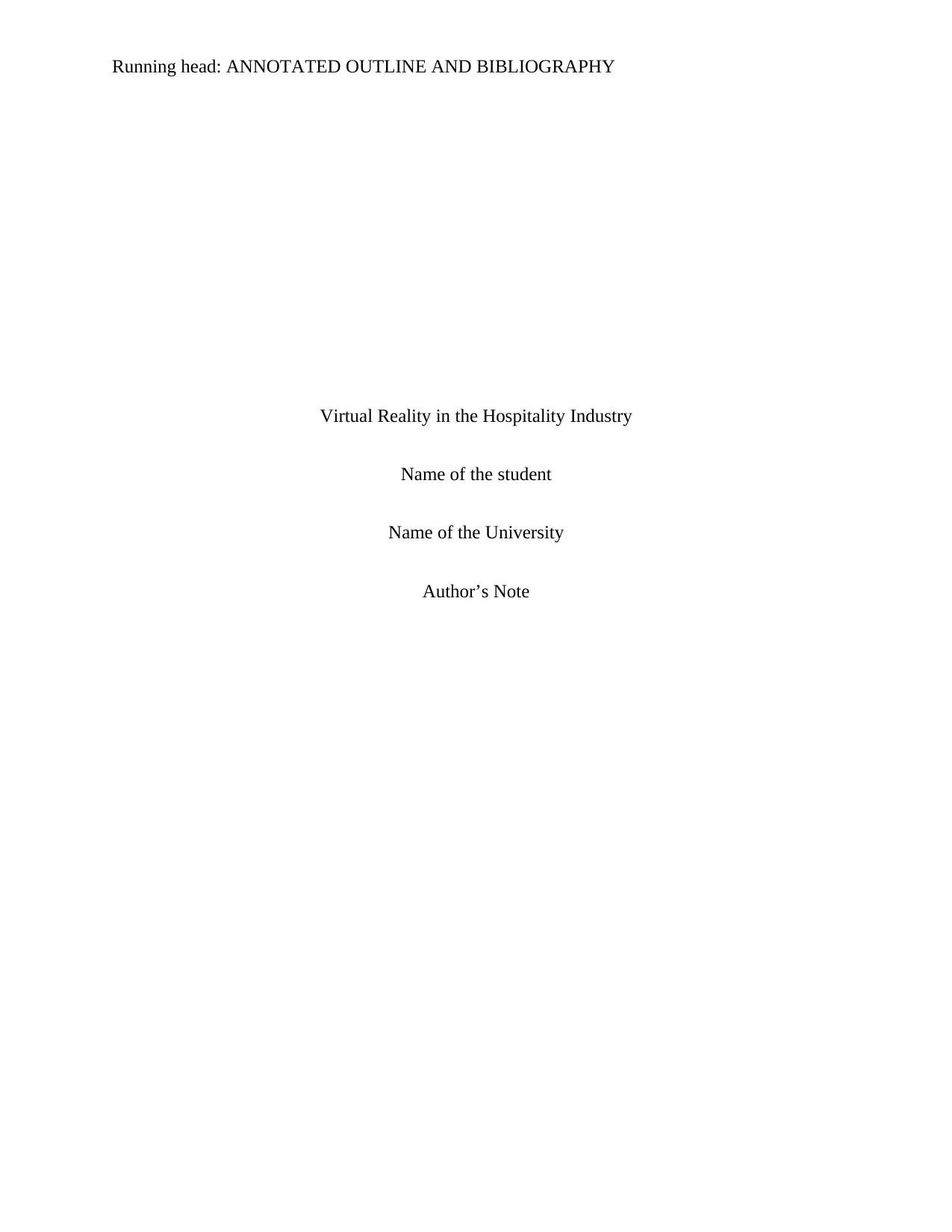
Running head: ANNOTATED OUTLINE AND BIBLIOGRAPHY
Virtual Reality in the Hospitality Industry
Name of the student
Name of the University
Author’s Note
Virtual Reality in the Hospitality Industry
Name of the student
Name of the University
Author’s Note
Secure Best Marks with AI Grader
Need help grading? Try our AI Grader for instant feedback on your assignments.
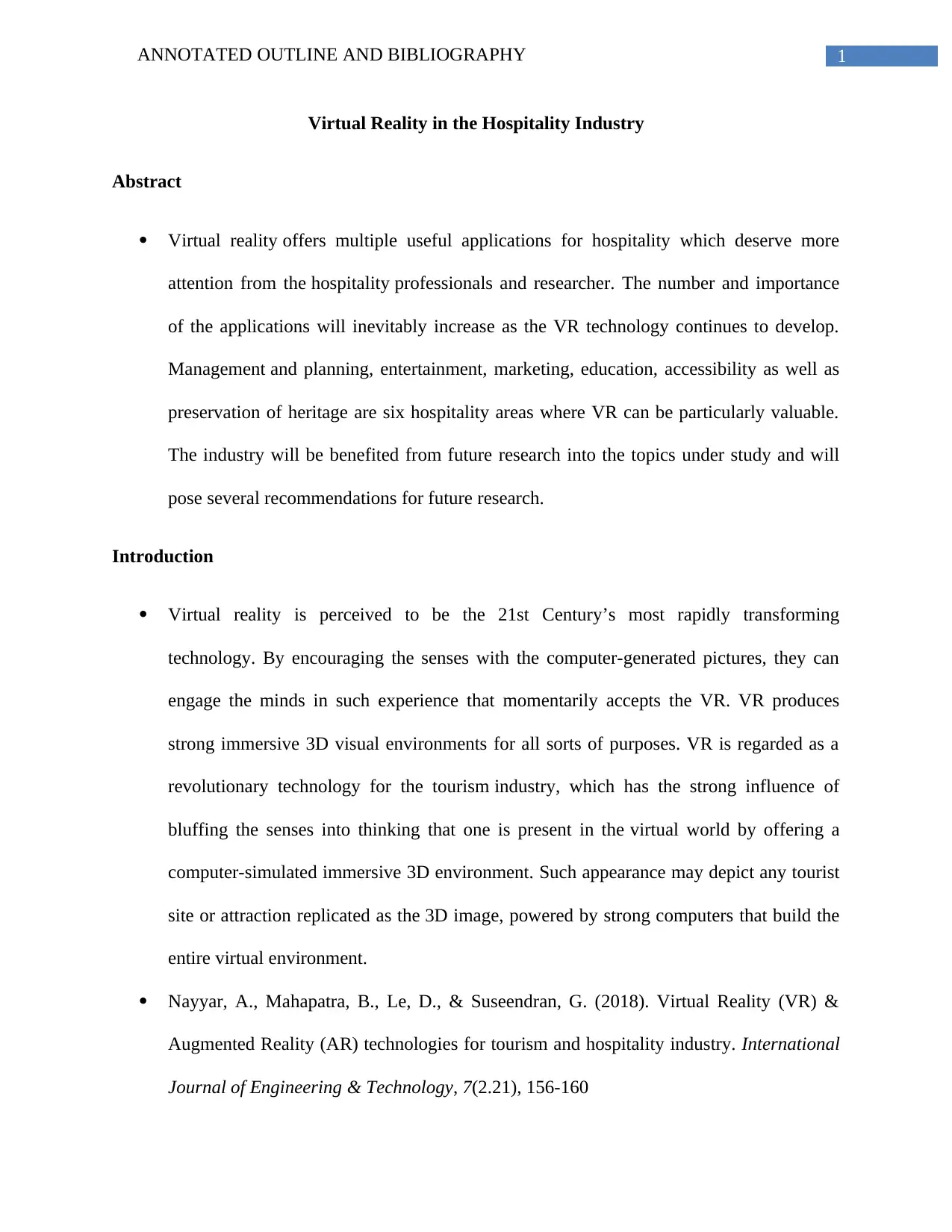
1ANNOTATED OUTLINE AND BIBLIOGRAPHY
Virtual Reality in the Hospitality Industry
Abstract
Virtual reality offers multiple useful applications for hospitality which deserve more
attention from the hospitality professionals and researcher. The number and importance
of the applications will inevitably increase as the VR technology continues to develop.
Management and planning, entertainment, marketing, education, accessibility as well as
preservation of heritage are six hospitality areas where VR can be particularly valuable.
The industry will be benefited from future research into the topics under study and will
pose several recommendations for future research.
Introduction
Virtual reality is perceived to be the 21st Century’s most rapidly transforming
technology. By encouraging the senses with the computer-generated pictures, they can
engage the minds in such experience that momentarily accepts the VR. VR produces
strong immersive 3D visual environments for all sorts of purposes. VR is regarded as a
revolutionary technology for the tourism industry, which has the strong influence of
bluffing the senses into thinking that one is present in the virtual world by offering a
computer-simulated immersive 3D environment. Such appearance may depict any tourist
site or attraction replicated as the 3D image, powered by strong computers that build the
entire virtual environment.
Nayyar, A., Mahapatra, B., Le, D., & Suseendran, G. (2018). Virtual Reality (VR) &
Augmented Reality (AR) technologies for tourism and hospitality industry. International
Journal of Engineering & Technology, 7(2.21), 156-160
Virtual Reality in the Hospitality Industry
Abstract
Virtual reality offers multiple useful applications for hospitality which deserve more
attention from the hospitality professionals and researcher. The number and importance
of the applications will inevitably increase as the VR technology continues to develop.
Management and planning, entertainment, marketing, education, accessibility as well as
preservation of heritage are six hospitality areas where VR can be particularly valuable.
The industry will be benefited from future research into the topics under study and will
pose several recommendations for future research.
Introduction
Virtual reality is perceived to be the 21st Century’s most rapidly transforming
technology. By encouraging the senses with the computer-generated pictures, they can
engage the minds in such experience that momentarily accepts the VR. VR produces
strong immersive 3D visual environments for all sorts of purposes. VR is regarded as a
revolutionary technology for the tourism industry, which has the strong influence of
bluffing the senses into thinking that one is present in the virtual world by offering a
computer-simulated immersive 3D environment. Such appearance may depict any tourist
site or attraction replicated as the 3D image, powered by strong computers that build the
entire virtual environment.
Nayyar, A., Mahapatra, B., Le, D., & Suseendran, G. (2018). Virtual Reality (VR) &
Augmented Reality (AR) technologies for tourism and hospitality industry. International
Journal of Engineering & Technology, 7(2.21), 156-160
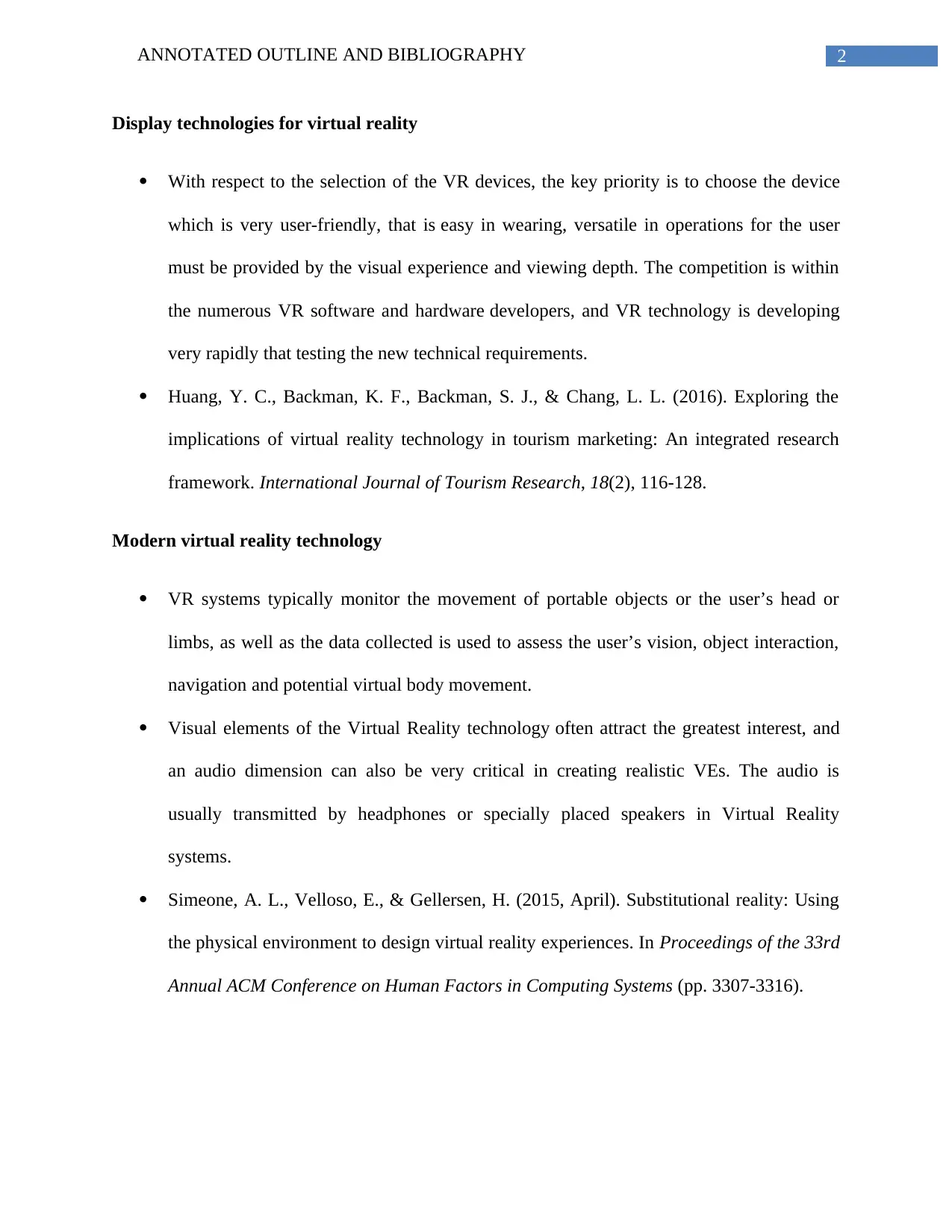
2ANNOTATED OUTLINE AND BIBLIOGRAPHY
Display technologies for virtual reality
With respect to the selection of the VR devices, the key priority is to choose the device
which is very user-friendly, that is easy in wearing, versatile in operations for the user
must be provided by the visual experience and viewing depth. The competition is within
the numerous VR software and hardware developers, and VR technology is developing
very rapidly that testing the new technical requirements.
Huang, Y. C., Backman, K. F., Backman, S. J., & Chang, L. L. (2016). Exploring the
implications of virtual reality technology in tourism marketing: An integrated research
framework. International Journal of Tourism Research, 18(2), 116-128.
Modern virtual reality technology
VR systems typically monitor the movement of portable objects or the user’s head or
limbs, as well as the data collected is used to assess the user’s vision, object interaction,
navigation and potential virtual body movement.
Visual elements of the Virtual Reality technology often attract the greatest interest, and
an audio dimension can also be very critical in creating realistic VEs. The audio is
usually transmitted by headphones or specially placed speakers in Virtual Reality
systems.
Simeone, A. L., Velloso, E., & Gellersen, H. (2015, April). Substitutional reality: Using
the physical environment to design virtual reality experiences. In Proceedings of the 33rd
Annual ACM Conference on Human Factors in Computing Systems (pp. 3307-3316).
Display technologies for virtual reality
With respect to the selection of the VR devices, the key priority is to choose the device
which is very user-friendly, that is easy in wearing, versatile in operations for the user
must be provided by the visual experience and viewing depth. The competition is within
the numerous VR software and hardware developers, and VR technology is developing
very rapidly that testing the new technical requirements.
Huang, Y. C., Backman, K. F., Backman, S. J., & Chang, L. L. (2016). Exploring the
implications of virtual reality technology in tourism marketing: An integrated research
framework. International Journal of Tourism Research, 18(2), 116-128.
Modern virtual reality technology
VR systems typically monitor the movement of portable objects or the user’s head or
limbs, as well as the data collected is used to assess the user’s vision, object interaction,
navigation and potential virtual body movement.
Visual elements of the Virtual Reality technology often attract the greatest interest, and
an audio dimension can also be very critical in creating realistic VEs. The audio is
usually transmitted by headphones or specially placed speakers in Virtual Reality
systems.
Simeone, A. L., Velloso, E., & Gellersen, H. (2015, April). Substitutional reality: Using
the physical environment to design virtual reality experiences. In Proceedings of the 33rd
Annual ACM Conference on Human Factors in Computing Systems (pp. 3307-3316).
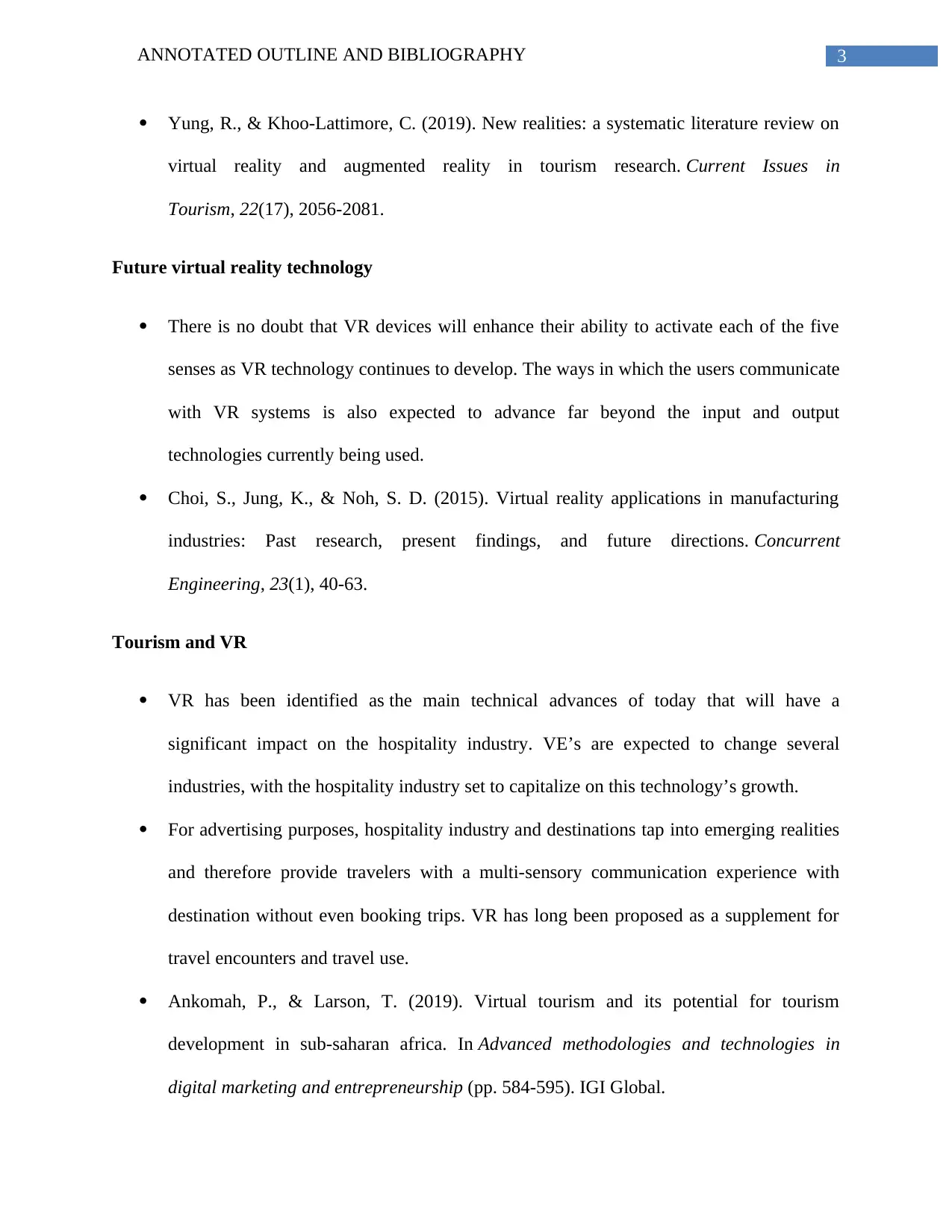
3ANNOTATED OUTLINE AND BIBLIOGRAPHY
Yung, R., & Khoo-Lattimore, C. (2019). New realities: a systematic literature review on
virtual reality and augmented reality in tourism research. Current Issues in
Tourism, 22(17), 2056-2081.
Future virtual reality technology
There is no doubt that VR devices will enhance their ability to activate each of the five
senses as VR technology continues to develop. The ways in which the users communicate
with VR systems is also expected to advance far beyond the input and output
technologies currently being used.
Choi, S., Jung, K., & Noh, S. D. (2015). Virtual reality applications in manufacturing
industries: Past research, present findings, and future directions. Concurrent
Engineering, 23(1), 40-63.
Tourism and VR
VR has been identified as the main technical advances of today that will have a
significant impact on the hospitality industry. VE’s are expected to change several
industries, with the hospitality industry set to capitalize on this technology’s growth.
For advertising purposes, hospitality industry and destinations tap into emerging realities
and therefore provide travelers with a multi-sensory communication experience with
destination without even booking trips. VR has long been proposed as a supplement for
travel encounters and travel use.
Ankomah, P., & Larson, T. (2019). Virtual tourism and its potential for tourism
development in sub-saharan africa. In Advanced methodologies and technologies in
digital marketing and entrepreneurship (pp. 584-595). IGI Global.
Yung, R., & Khoo-Lattimore, C. (2019). New realities: a systematic literature review on
virtual reality and augmented reality in tourism research. Current Issues in
Tourism, 22(17), 2056-2081.
Future virtual reality technology
There is no doubt that VR devices will enhance their ability to activate each of the five
senses as VR technology continues to develop. The ways in which the users communicate
with VR systems is also expected to advance far beyond the input and output
technologies currently being used.
Choi, S., Jung, K., & Noh, S. D. (2015). Virtual reality applications in manufacturing
industries: Past research, present findings, and future directions. Concurrent
Engineering, 23(1), 40-63.
Tourism and VR
VR has been identified as the main technical advances of today that will have a
significant impact on the hospitality industry. VE’s are expected to change several
industries, with the hospitality industry set to capitalize on this technology’s growth.
For advertising purposes, hospitality industry and destinations tap into emerging realities
and therefore provide travelers with a multi-sensory communication experience with
destination without even booking trips. VR has long been proposed as a supplement for
travel encounters and travel use.
Ankomah, P., & Larson, T. (2019). Virtual tourism and its potential for tourism
development in sub-saharan africa. In Advanced methodologies and technologies in
digital marketing and entrepreneurship (pp. 584-595). IGI Global.
Secure Best Marks with AI Grader
Need help grading? Try our AI Grader for instant feedback on your assignments.
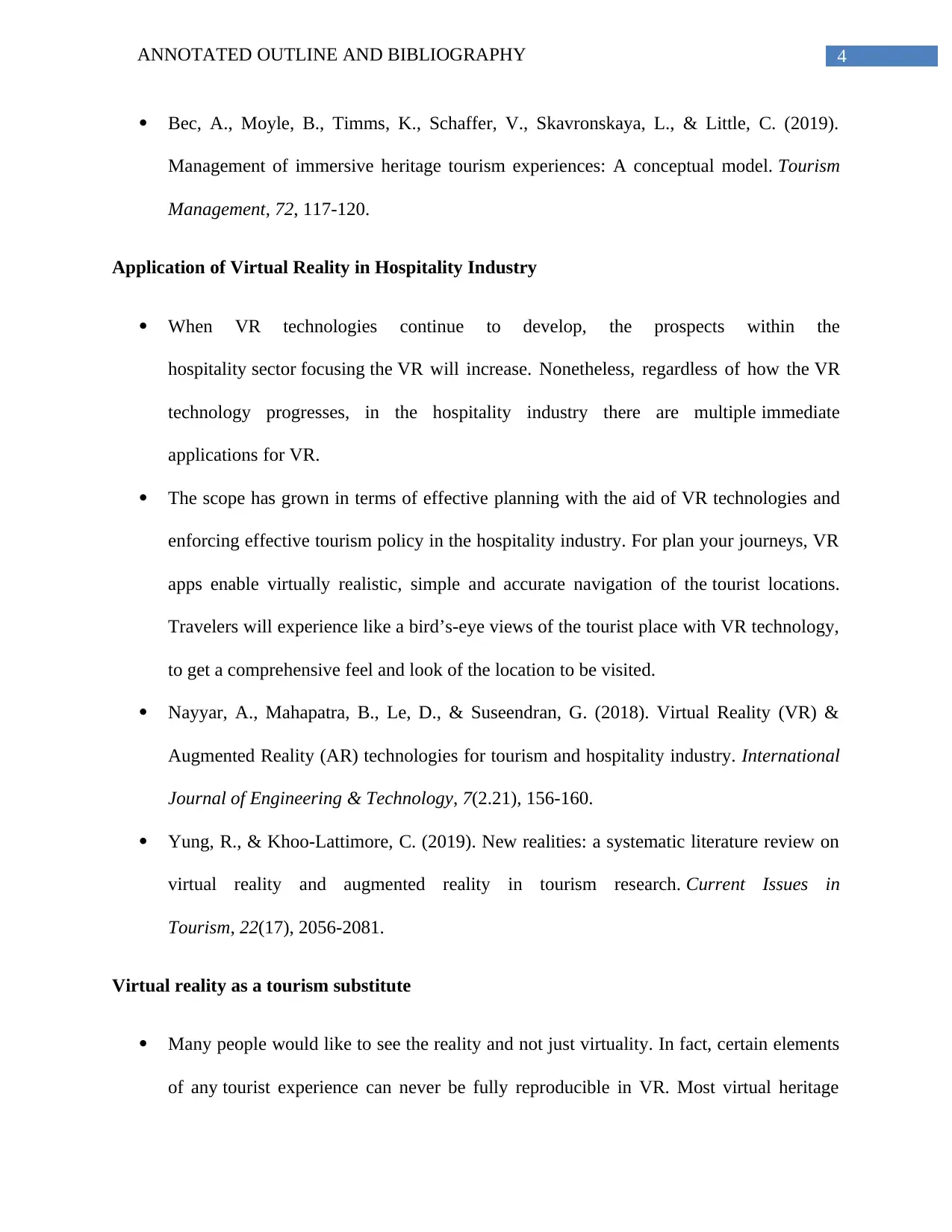
4ANNOTATED OUTLINE AND BIBLIOGRAPHY
Bec, A., Moyle, B., Timms, K., Schaffer, V., Skavronskaya, L., & Little, C. (2019).
Management of immersive heritage tourism experiences: A conceptual model. Tourism
Management, 72, 117-120.
Application of Virtual Reality in Hospitality Industry
When VR technologies continue to develop, the prospects within the
hospitality sector focusing the VR will increase. Nonetheless, regardless of how the VR
technology progresses, in the hospitality industry there are multiple immediate
applications for VR.
The scope has grown in terms of effective planning with the aid of VR technologies and
enforcing effective tourism policy in the hospitality industry. For plan your journeys, VR
apps enable virtually realistic, simple and accurate navigation of the tourist locations.
Travelers will experience like a bird’s-eye views of the tourist place with VR technology,
to get a comprehensive feel and look of the location to be visited.
Nayyar, A., Mahapatra, B., Le, D., & Suseendran, G. (2018). Virtual Reality (VR) &
Augmented Reality (AR) technologies for tourism and hospitality industry. International
Journal of Engineering & Technology, 7(2.21), 156-160.
Yung, R., & Khoo-Lattimore, C. (2019). New realities: a systematic literature review on
virtual reality and augmented reality in tourism research. Current Issues in
Tourism, 22(17), 2056-2081.
Virtual reality as a tourism substitute
Many people would like to see the reality and not just virtuality. In fact, certain elements
of any tourist experience can never be fully reproducible in VR. Most virtual heritage
Bec, A., Moyle, B., Timms, K., Schaffer, V., Skavronskaya, L., & Little, C. (2019).
Management of immersive heritage tourism experiences: A conceptual model. Tourism
Management, 72, 117-120.
Application of Virtual Reality in Hospitality Industry
When VR technologies continue to develop, the prospects within the
hospitality sector focusing the VR will increase. Nonetheless, regardless of how the VR
technology progresses, in the hospitality industry there are multiple immediate
applications for VR.
The scope has grown in terms of effective planning with the aid of VR technologies and
enforcing effective tourism policy in the hospitality industry. For plan your journeys, VR
apps enable virtually realistic, simple and accurate navigation of the tourist locations.
Travelers will experience like a bird’s-eye views of the tourist place with VR technology,
to get a comprehensive feel and look of the location to be visited.
Nayyar, A., Mahapatra, B., Le, D., & Suseendran, G. (2018). Virtual Reality (VR) &
Augmented Reality (AR) technologies for tourism and hospitality industry. International
Journal of Engineering & Technology, 7(2.21), 156-160.
Yung, R., & Khoo-Lattimore, C. (2019). New realities: a systematic literature review on
virtual reality and augmented reality in tourism research. Current Issues in
Tourism, 22(17), 2056-2081.
Virtual reality as a tourism substitute
Many people would like to see the reality and not just virtuality. In fact, certain elements
of any tourist experience can never be fully reproducible in VR. Most virtual heritage

5ANNOTATED OUTLINE AND BIBLIOGRAPHY
researchers claim that their work inspires visitors to see the real site, providing the visitor
extra information to improve the actual visit to the site.
A user’s interpretation of the VR experience’s authenticity will be the factor affecting the
acceptance of it as the VR replacement. Obviously, VR experiences are fundamentally
inauthentic when assessed with the objective, criteria-based authenticity evaluation.
The willingness of a person to consider a replacement for VR tourism will also be
affected by the reasons behind his or her preference for the specific experience. Tourists
frequently travel for fun but may also have other, more nuanced motives. This may
involve personal motives
Bogicevic, V., Seo, S., Kandampully, J. A., Liu, S. Q., & Rudd, N. A. (2019). Virtual
reality presence as a preamble of tourism experience: The role of mental
imagery. Tourism Management, 74, 55-64.
Najafipour, A. A., Heidari, M., & Foroozanfar, M. H. (2014). Describing the virtual
reality and virtual tourist community (applications and implications for tourism
industry). Kuwait Chapter of the Arabian Journal of Business and Management
Review, 3(12A), 12.
Benefits of Virtual Reality in Hospitality Industry
Many travelers will feel more relaxed because they have seen the aircraft and know the
location of all emergency exits. Virtual reality offers visitors the opportunity to take off
on the 3D plane ride prior to departure.
VR’s future in hospitality industry is not completely absolving actual tours. Alternatively,
travel coordinators will consider the advantages of virtual reality in tourism as regards
presentations.
researchers claim that their work inspires visitors to see the real site, providing the visitor
extra information to improve the actual visit to the site.
A user’s interpretation of the VR experience’s authenticity will be the factor affecting the
acceptance of it as the VR replacement. Obviously, VR experiences are fundamentally
inauthentic when assessed with the objective, criteria-based authenticity evaluation.
The willingness of a person to consider a replacement for VR tourism will also be
affected by the reasons behind his or her preference for the specific experience. Tourists
frequently travel for fun but may also have other, more nuanced motives. This may
involve personal motives
Bogicevic, V., Seo, S., Kandampully, J. A., Liu, S. Q., & Rudd, N. A. (2019). Virtual
reality presence as a preamble of tourism experience: The role of mental
imagery. Tourism Management, 74, 55-64.
Najafipour, A. A., Heidari, M., & Foroozanfar, M. H. (2014). Describing the virtual
reality and virtual tourist community (applications and implications for tourism
industry). Kuwait Chapter of the Arabian Journal of Business and Management
Review, 3(12A), 12.
Benefits of Virtual Reality in Hospitality Industry
Many travelers will feel more relaxed because they have seen the aircraft and know the
location of all emergency exits. Virtual reality offers visitors the opportunity to take off
on the 3D plane ride prior to departure.
VR’s future in hospitality industry is not completely absolving actual tours. Alternatively,
travel coordinators will consider the advantages of virtual reality in tourism as regards
presentations.
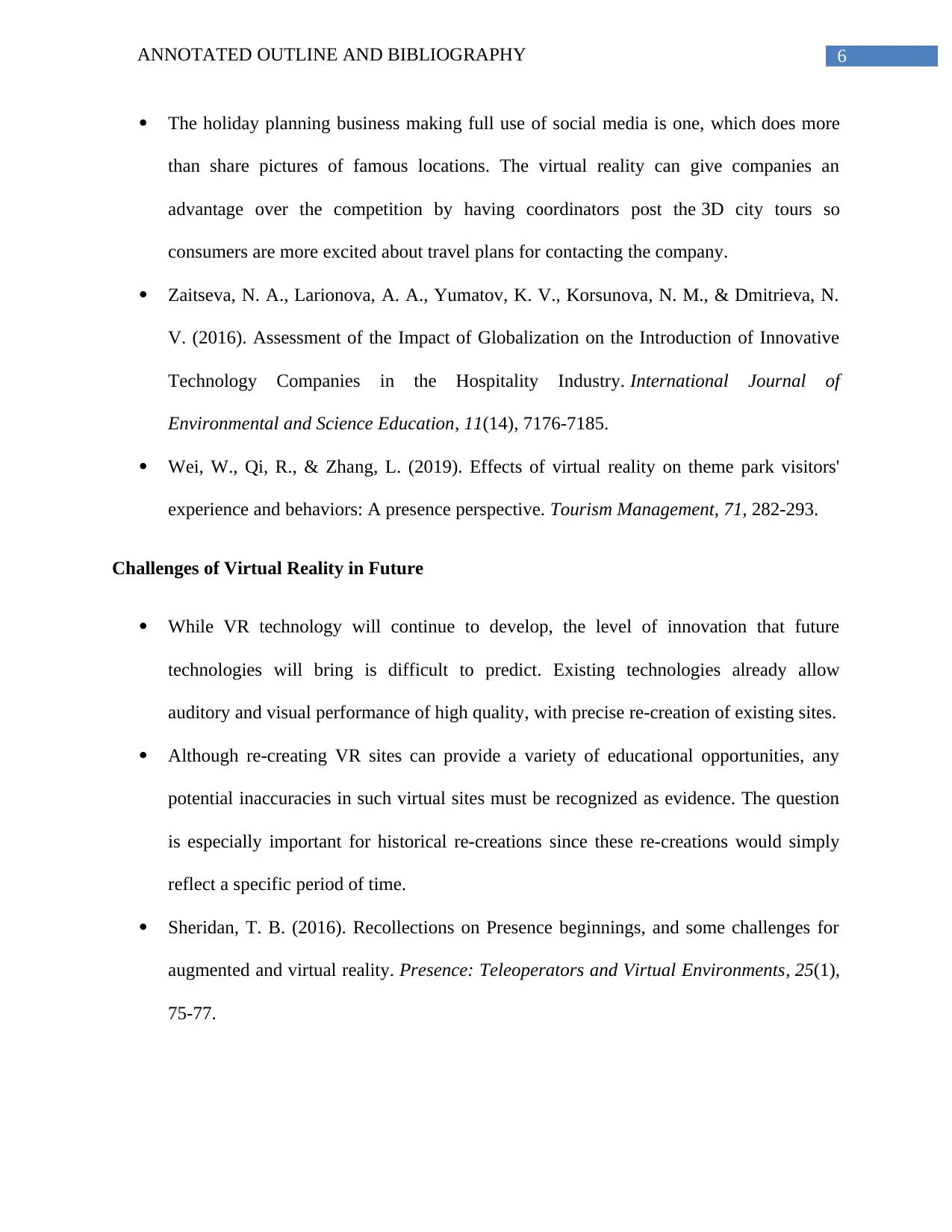
6ANNOTATED OUTLINE AND BIBLIOGRAPHY
The holiday planning business making full use of social media is one, which does more
than share pictures of famous locations. The virtual reality can give companies an
advantage over the competition by having coordinators post the 3D city tours so
consumers are more excited about travel plans for contacting the company.
Zaitseva, N. A., Larionova, A. A., Yumatov, K. V., Korsunova, N. M., & Dmitrieva, N.
V. (2016). Assessment of the Impact of Globalization on the Introduction of Innovative
Technology Companies in the Hospitality Industry. International Journal of
Environmental and Science Education, 11(14), 7176-7185.
Wei, W., Qi, R., & Zhang, L. (2019). Effects of virtual reality on theme park visitors'
experience and behaviors: A presence perspective. Tourism Management, 71, 282-293.
Challenges of Virtual Reality in Future
While VR technology will continue to develop, the level of innovation that future
technologies will bring is difficult to predict. Existing technologies already allow
auditory and visual performance of high quality, with precise re-creation of existing sites.
Although re-creating VR sites can provide a variety of educational opportunities, any
potential inaccuracies in such virtual sites must be recognized as evidence. The question
is especially important for historical re-creations since these re-creations would simply
reflect a specific period of time.
Sheridan, T. B. (2016). Recollections on Presence beginnings, and some challenges for
augmented and virtual reality. Presence: Teleoperators and Virtual Environments, 25(1),
75-77.
The holiday planning business making full use of social media is one, which does more
than share pictures of famous locations. The virtual reality can give companies an
advantage over the competition by having coordinators post the 3D city tours so
consumers are more excited about travel plans for contacting the company.
Zaitseva, N. A., Larionova, A. A., Yumatov, K. V., Korsunova, N. M., & Dmitrieva, N.
V. (2016). Assessment of the Impact of Globalization on the Introduction of Innovative
Technology Companies in the Hospitality Industry. International Journal of
Environmental and Science Education, 11(14), 7176-7185.
Wei, W., Qi, R., & Zhang, L. (2019). Effects of virtual reality on theme park visitors'
experience and behaviors: A presence perspective. Tourism Management, 71, 282-293.
Challenges of Virtual Reality in Future
While VR technology will continue to develop, the level of innovation that future
technologies will bring is difficult to predict. Existing technologies already allow
auditory and visual performance of high quality, with precise re-creation of existing sites.
Although re-creating VR sites can provide a variety of educational opportunities, any
potential inaccuracies in such virtual sites must be recognized as evidence. The question
is especially important for historical re-creations since these re-creations would simply
reflect a specific period of time.
Sheridan, T. B. (2016). Recollections on Presence beginnings, and some challenges for
augmented and virtual reality. Presence: Teleoperators and Virtual Environments, 25(1),
75-77.
Paraphrase This Document
Need a fresh take? Get an instant paraphrase of this document with our AI Paraphraser

7ANNOTATED OUTLINE AND BIBLIOGRAPHY
Gibson, A., & O’Rawe, M. (2018). Virtual reality as a travel promotional tool: Insights
from a consumer travel fair. In Augmented reality and virtual reality (pp. 93-107).
Springer, Cham.
Conclusion
Virtual Reality enabling technology, the most common VR equipment and other
VR applications use cases for the hospitality industry. This evaluated the successes,
shortcomings and challenges for designing and using VR applications to boost current
marketing funnel designs, increase consumer conversion levels and thus provide the
added value as well as ROI needed.
Gibson, A., & O’Rawe, M. (2018). Virtual reality as a travel promotional tool: Insights
from a consumer travel fair. In Augmented reality and virtual reality (pp. 93-107).
Springer, Cham.
Conclusion
Virtual Reality enabling technology, the most common VR equipment and other
VR applications use cases for the hospitality industry. This evaluated the successes,
shortcomings and challenges for designing and using VR applications to boost current
marketing funnel designs, increase consumer conversion levels and thus provide the
added value as well as ROI needed.
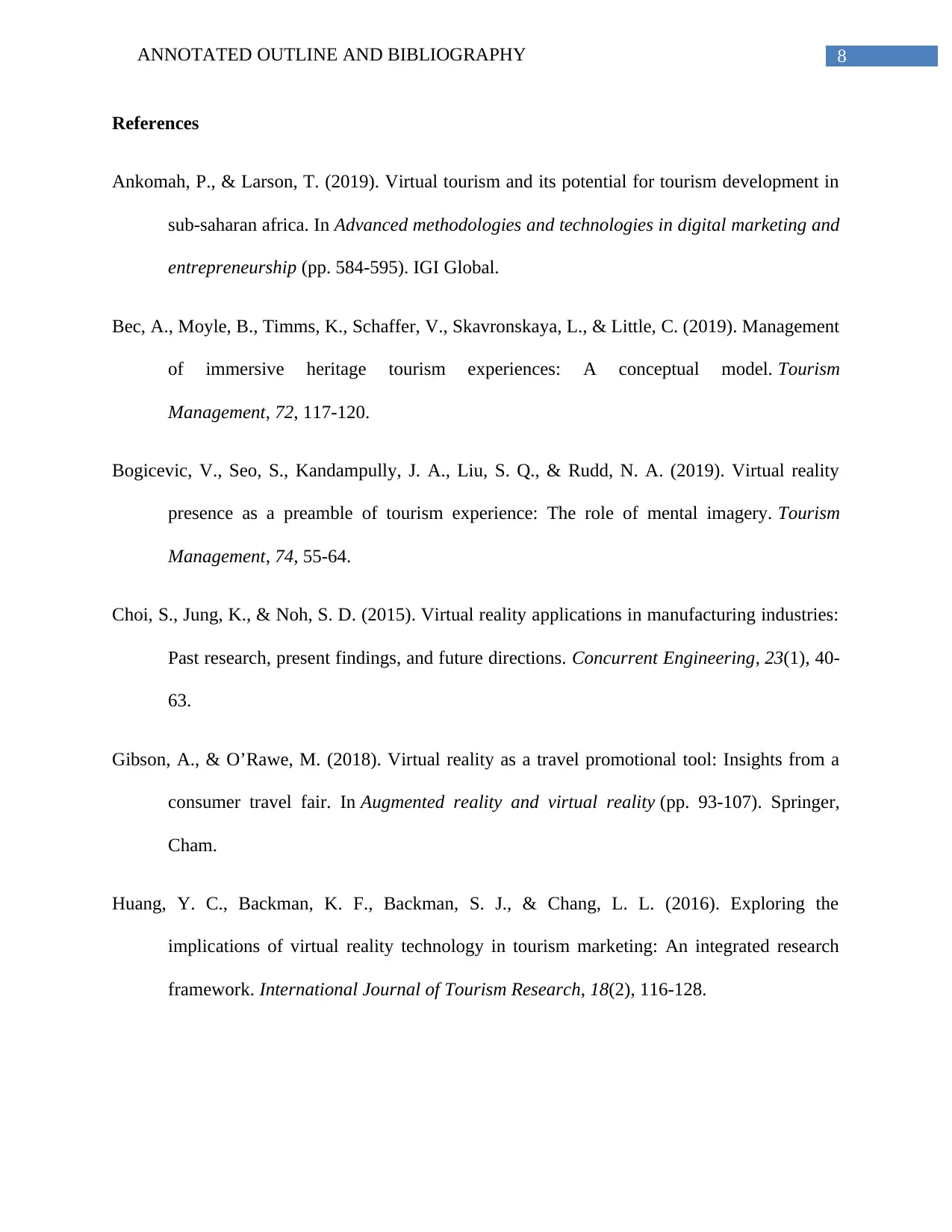
8ANNOTATED OUTLINE AND BIBLIOGRAPHY
References
Ankomah, P., & Larson, T. (2019). Virtual tourism and its potential for tourism development in
sub-saharan africa. In Advanced methodologies and technologies in digital marketing and
entrepreneurship (pp. 584-595). IGI Global.
Bec, A., Moyle, B., Timms, K., Schaffer, V., Skavronskaya, L., & Little, C. (2019). Management
of immersive heritage tourism experiences: A conceptual model. Tourism
Management, 72, 117-120.
Bogicevic, V., Seo, S., Kandampully, J. A., Liu, S. Q., & Rudd, N. A. (2019). Virtual reality
presence as a preamble of tourism experience: The role of mental imagery. Tourism
Management, 74, 55-64.
Choi, S., Jung, K., & Noh, S. D. (2015). Virtual reality applications in manufacturing industries:
Past research, present findings, and future directions. Concurrent Engineering, 23(1), 40-
63.
Gibson, A., & O’Rawe, M. (2018). Virtual reality as a travel promotional tool: Insights from a
consumer travel fair. In Augmented reality and virtual reality (pp. 93-107). Springer,
Cham.
Huang, Y. C., Backman, K. F., Backman, S. J., & Chang, L. L. (2016). Exploring the
implications of virtual reality technology in tourism marketing: An integrated research
framework. International Journal of Tourism Research, 18(2), 116-128.
References
Ankomah, P., & Larson, T. (2019). Virtual tourism and its potential for tourism development in
sub-saharan africa. In Advanced methodologies and technologies in digital marketing and
entrepreneurship (pp. 584-595). IGI Global.
Bec, A., Moyle, B., Timms, K., Schaffer, V., Skavronskaya, L., & Little, C. (2019). Management
of immersive heritage tourism experiences: A conceptual model. Tourism
Management, 72, 117-120.
Bogicevic, V., Seo, S., Kandampully, J. A., Liu, S. Q., & Rudd, N. A. (2019). Virtual reality
presence as a preamble of tourism experience: The role of mental imagery. Tourism
Management, 74, 55-64.
Choi, S., Jung, K., & Noh, S. D. (2015). Virtual reality applications in manufacturing industries:
Past research, present findings, and future directions. Concurrent Engineering, 23(1), 40-
63.
Gibson, A., & O’Rawe, M. (2018). Virtual reality as a travel promotional tool: Insights from a
consumer travel fair. In Augmented reality and virtual reality (pp. 93-107). Springer,
Cham.
Huang, Y. C., Backman, K. F., Backman, S. J., & Chang, L. L. (2016). Exploring the
implications of virtual reality technology in tourism marketing: An integrated research
framework. International Journal of Tourism Research, 18(2), 116-128.
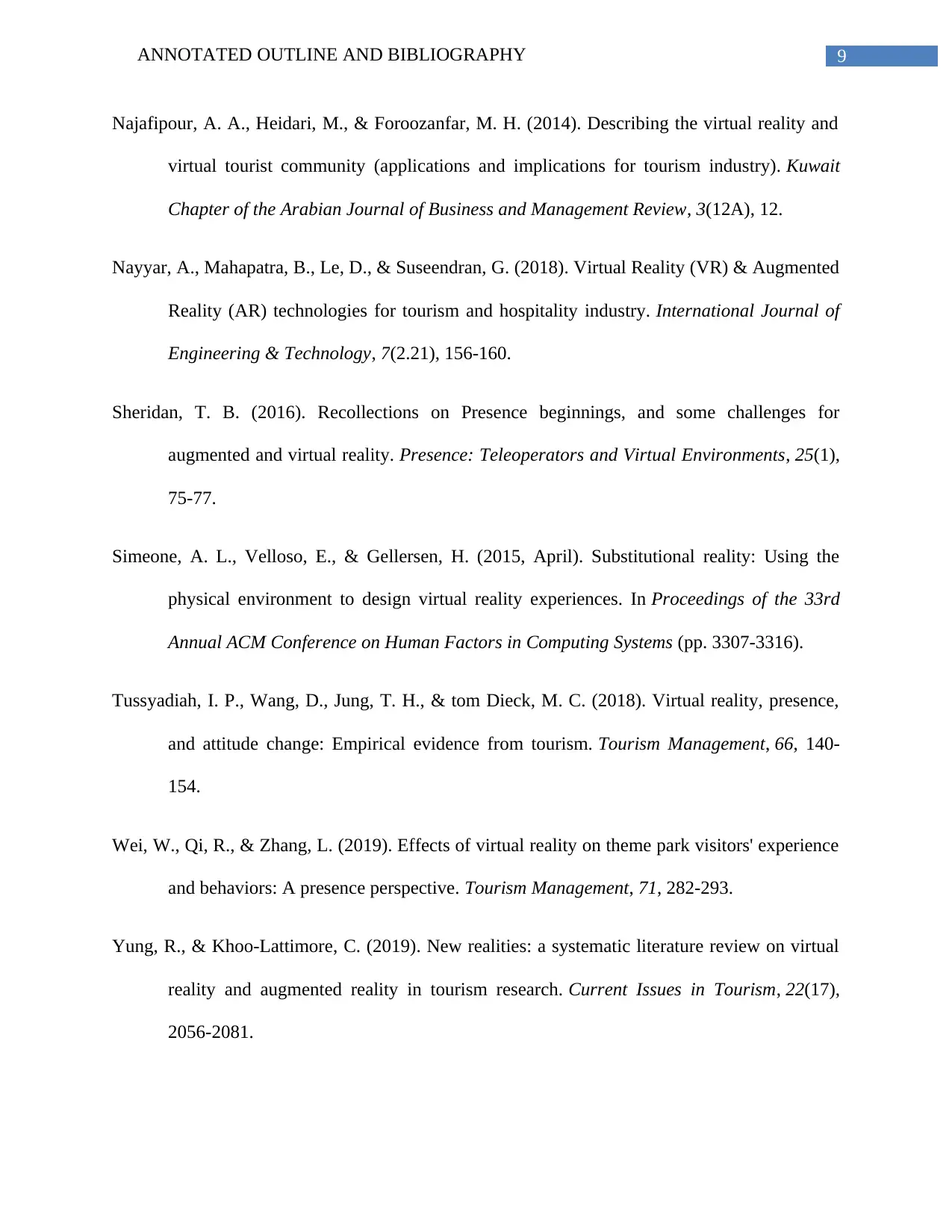
9ANNOTATED OUTLINE AND BIBLIOGRAPHY
Najafipour, A. A., Heidari, M., & Foroozanfar, M. H. (2014). Describing the virtual reality and
virtual tourist community (applications and implications for tourism industry). Kuwait
Chapter of the Arabian Journal of Business and Management Review, 3(12A), 12.
Nayyar, A., Mahapatra, B., Le, D., & Suseendran, G. (2018). Virtual Reality (VR) & Augmented
Reality (AR) technologies for tourism and hospitality industry. International Journal of
Engineering & Technology, 7(2.21), 156-160.
Sheridan, T. B. (2016). Recollections on Presence beginnings, and some challenges for
augmented and virtual reality. Presence: Teleoperators and Virtual Environments, 25(1),
75-77.
Simeone, A. L., Velloso, E., & Gellersen, H. (2015, April). Substitutional reality: Using the
physical environment to design virtual reality experiences. In Proceedings of the 33rd
Annual ACM Conference on Human Factors in Computing Systems (pp. 3307-3316).
Tussyadiah, I. P., Wang, D., Jung, T. H., & tom Dieck, M. C. (2018). Virtual reality, presence,
and attitude change: Empirical evidence from tourism. Tourism Management, 66, 140-
154.
Wei, W., Qi, R., & Zhang, L. (2019). Effects of virtual reality on theme park visitors' experience
and behaviors: A presence perspective. Tourism Management, 71, 282-293.
Yung, R., & Khoo-Lattimore, C. (2019). New realities: a systematic literature review on virtual
reality and augmented reality in tourism research. Current Issues in Tourism, 22(17),
2056-2081.
Najafipour, A. A., Heidari, M., & Foroozanfar, M. H. (2014). Describing the virtual reality and
virtual tourist community (applications and implications for tourism industry). Kuwait
Chapter of the Arabian Journal of Business and Management Review, 3(12A), 12.
Nayyar, A., Mahapatra, B., Le, D., & Suseendran, G. (2018). Virtual Reality (VR) & Augmented
Reality (AR) technologies for tourism and hospitality industry. International Journal of
Engineering & Technology, 7(2.21), 156-160.
Sheridan, T. B. (2016). Recollections on Presence beginnings, and some challenges for
augmented and virtual reality. Presence: Teleoperators and Virtual Environments, 25(1),
75-77.
Simeone, A. L., Velloso, E., & Gellersen, H. (2015, April). Substitutional reality: Using the
physical environment to design virtual reality experiences. In Proceedings of the 33rd
Annual ACM Conference on Human Factors in Computing Systems (pp. 3307-3316).
Tussyadiah, I. P., Wang, D., Jung, T. H., & tom Dieck, M. C. (2018). Virtual reality, presence,
and attitude change: Empirical evidence from tourism. Tourism Management, 66, 140-
154.
Wei, W., Qi, R., & Zhang, L. (2019). Effects of virtual reality on theme park visitors' experience
and behaviors: A presence perspective. Tourism Management, 71, 282-293.
Yung, R., & Khoo-Lattimore, C. (2019). New realities: a systematic literature review on virtual
reality and augmented reality in tourism research. Current Issues in Tourism, 22(17),
2056-2081.
Secure Best Marks with AI Grader
Need help grading? Try our AI Grader for instant feedback on your assignments.
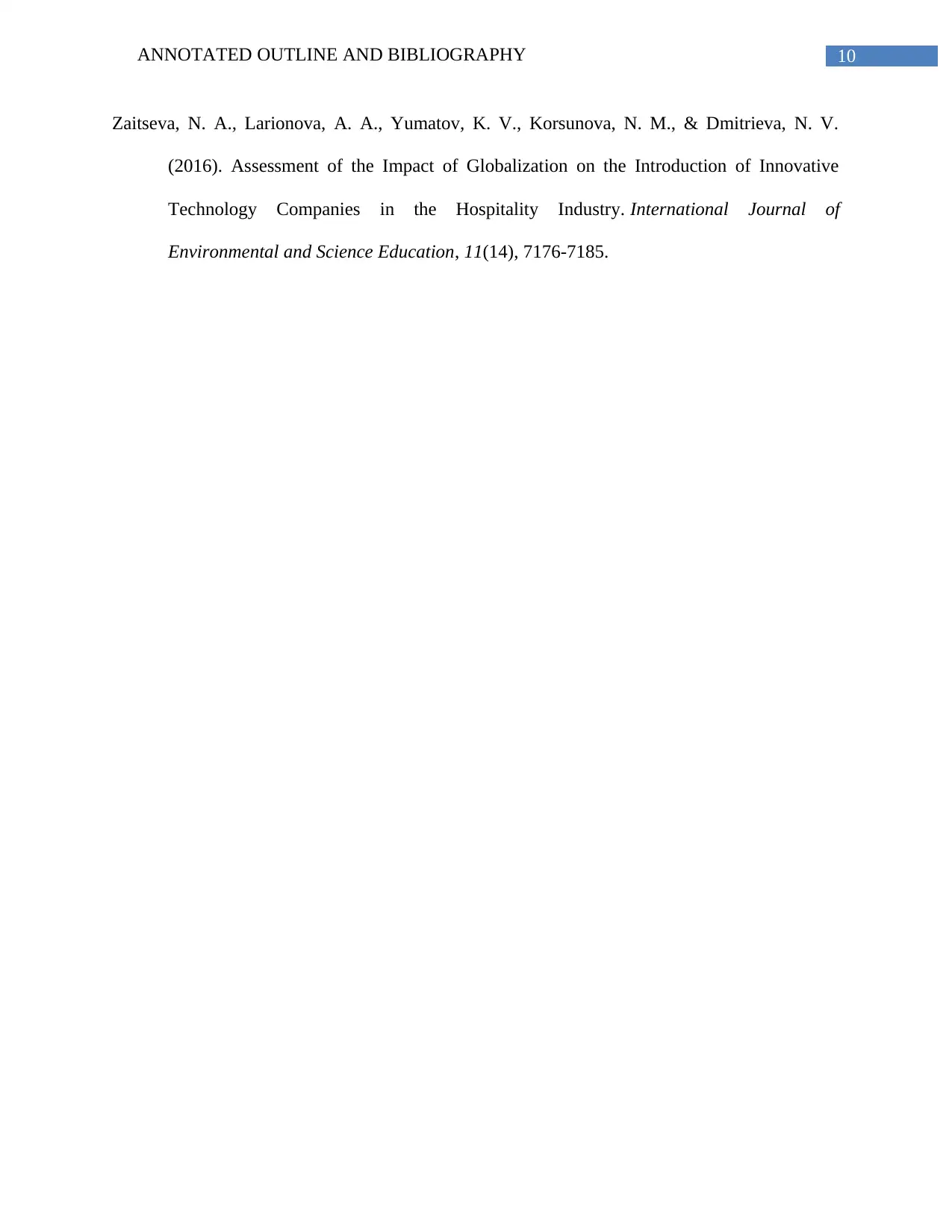
10ANNOTATED OUTLINE AND BIBLIOGRAPHY
Zaitseva, N. A., Larionova, A. A., Yumatov, K. V., Korsunova, N. M., & Dmitrieva, N. V.
(2016). Assessment of the Impact of Globalization on the Introduction of Innovative
Technology Companies in the Hospitality Industry. International Journal of
Environmental and Science Education, 11(14), 7176-7185.
Zaitseva, N. A., Larionova, A. A., Yumatov, K. V., Korsunova, N. M., & Dmitrieva, N. V.
(2016). Assessment of the Impact of Globalization on the Introduction of Innovative
Technology Companies in the Hospitality Industry. International Journal of
Environmental and Science Education, 11(14), 7176-7185.
1 out of 11
Related Documents
Your All-in-One AI-Powered Toolkit for Academic Success.
+13062052269
info@desklib.com
Available 24*7 on WhatsApp / Email
![[object Object]](/_next/static/media/star-bottom.7253800d.svg)
Unlock your academic potential
© 2024 | Zucol Services PVT LTD | All rights reserved.





